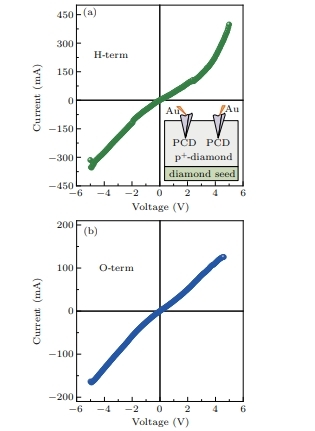Pos:
Home KnowledgeTechnologyOhmic and Schottky contacts of hydrogenated and oxygenated boron-doped single-crystal diamond with hill-like polycrAs an extremely functional material with excellent properties, for example a wide band gap, high thermal conductivity, high electron and hole mobility, high breakdown volt-age, chemical inertness and biocompatibility, diamond has been widely applied in high-frequency and high-power electronic devices, including Schottky barrier diodes, PN diodes and field-effect transistors. Device performances, especially the breakdown field, are still far below the theoretical limit of diamond. A thicker epitaxial layer with good crystalline quality and low defect density is required to suppress the leakage current and realize high breakdown voltage.
Herein, by adjusting the CVD growth process of the heavily boron-doped p+ SVD film, the high-density polycrystalline grains appear to extend to the SCD surface, where a relatively higher boron concentration is present, The leakage path and ohmic contact to the gold (Au) electrode are demonstrated and the electrical conductivity is related to the type of surface termination (oxygenation or hydrogenation).Interestingly, different rectification characteristics are found in oxygen-terminated HPDG and SCD, determined by differences in boron doping levels.
The characteristics on surfaces with HPDG and SCD contacts were measured using a Keithley 2450 source meter with two gold (Au) probes (inset of Fig. 3). Obviously,the conductivity characteristic between two adjacent HPDGs of the as-grown sample (hydrogen-terminated surface) has a nearly linear curve, as shown in Fig. 3(a), implying the formation of an ohmic-like contact. Although the current obviously decreases, a linear curve is maintained for the neighboring oxygen-terminated HPDG surface after acid boiling treatment (Fig,3(b)), as surface oxygenation could increase the resistance of BDD,For comparison, the curve obtained from the hydrogen-terminated SCD surface in the as-grown sample is also nearly linear and has a similar current density (Fig, 3(c)) comparing to the case in Fig. 3(a).However, oxygen termination changes the i-y curve, giving it symmetry rectification characteristics (Fig, 3(d), which could be ascribed to the formation of a back-to-back Schottky diode(as discussed in the following paragraph). Based on these results, we can conclude that the surface termination can modulate the contact properties, especially for SCD with a lower boron concentration ralative to HPDG.
Generally, the surface of diamond after homoepitaxial growth is hydrogen terminated, because the main gas source in the MPCVD chamber is hydrogen. On the one hand, hydrogen termination provides a negative electron affinity of 1.3 eV and helps to upshift the energy band of diamond.On the other hand, hydrogen termination generates a high concentration of two-dimensional hole gas (2DHG) on the surface, resulting in upward band bending and high surface conductance.Those two factors can significantly reduce the Schottky barrier height between Au (with a work function of approximately 5.0 eV) and diamond, resulting in an ohmic-like contact (Figs. 3(a) and 3(c)). For oxygen termination, the electron affinity of the diamond surface can be easily adjusted by the C–O bonds, which gives a positive electron
affinity of approximately 0.5 eV. In addition, unlike ‘transfer doping’ in hydrogen-terminated diamond which forms a 2DHG channel, the oxygen-terminated surface is nearly insulate. Those two factors cause the Au/diamond contact to be a Schottky contact. Therefore, the two Au/diamond contacts form a back-to-back Schottky diode, leading to a symmetry rectification characteristic (Fig. 3(d)). On the other hand, the relatively higher boron doping concentration in the HPDG will broaden the acceptor energy band near the top of the valence band. In addition, the high density of dangling bonds and distorted sp2 -bonded carbon at the grain boundaries introduce broad π and π ∗ defect states in the bandgap of diamond.Those two factors act as a conducting channel, facilitating easy tunneling of the hole, which can weaken the termination dependence and facilitate the formation of an ohmic contact (Fig. 3(b)). This assumption is confirmed by putting two probes on the oxygen-terminated HPDG and SCD regions, respectively, showing an obvious rectification characteristic, as expected (Fig. 4(a)). Reversibly, the I–V curve returns to symmetry when the sample was re-treated (Fig. 4(b)).

The I–V characteristics measured with two gold probes indicate that the I–V curve obtained from single-crystalline regions on an as-grown sample are nearly linear showing ohmic contact. A back-to-back Schottky diode could be formed after oxygen termination. This result confirms that the Au/diamond contact can be modulated by the type of surface termination. For the HPDG regions, the nearly linear I–V curve is retained for both oxygen termination and hydrogen termination, implying the ohmic contact is always maintained between Au and polycrystalline regions. This result experimentally confirms that the grains with abundant boundaries result in leakage paths and affect the contact properties. Therefore, HPDGs provide an approach to construct junctions or improve electrode contacts on doped semiconductor SCDs or devices.
The boron-doped single-crystal diamond produced by CSMH can achieve doping from low concentration to high concentration. It has realized a uniform and controllable concentration and a customizable boron doping process.Lightly B-doped diamonds offer excellent carrier mobility, making them ideal substrates for semiconductor applications. Heavily B-doped diamonds provide low electrical resistance, serving as conductive electrodes for ohmic contacts.Furthermore, it is an ideal material for the fabrication of high-temperature, high-power semiconductor components and can also be used in electrochemistry.Additionally, CSMH offers high-quality diamond wafer substrates (e.g., on Si or SiC), enabling customers to develop advanced semiconductor devices.
 闽ICP备2021005558号-1
闽ICP备2021005558号-1Leave A Message